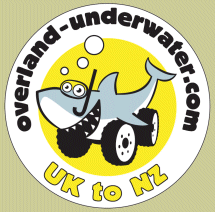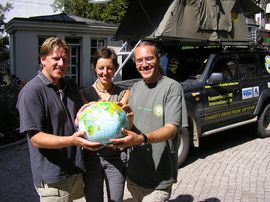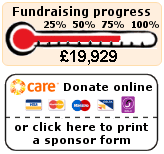| Final Statistics: Alex & Maz | Total distance: 93,550km |
| Furthest Point: Rotorua, NZ | Now settled in Sydney, Australia |
| Final Statistics: Martin | Total distance: 79,698km |
| Furthest Point: Hobart, Australia | Now settled in Bristol, UK |
A Silver Pagoda and Some Sombre Moments
Cambodia, Country 21, Diary entry 6th-12th May 2006, Total distance in Cambodia: 2478km
Second part of the Ian Pitwood trilogy...
Having spent three days doing saturation sightseeing in the Angkor area we started to move east towards the Mekong River. The first day's leisurely drive along a very good road took us to Kompong Thom. About 5 km before reaching the town however, we turned north towards Sambor Prei Kuk. This is the most impressive group of pre-Angkorian monuments in Cambodia. There are more than 100 small temples scattered through the forest, and they are some of the oldest structures in the country having been built some 3-4 centuries before the temples at Angkor.
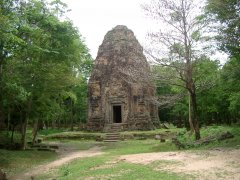 The central complex of temples consists of four groups of towers, most of which are made of brick. Years of monsoon rains have not been kind to the brick carvings on the exterior. The principal group, known as Prasat Sambor is dedicated to Gambhiresh-vara, one of Shiva's many incarnations. The other groups are all dedicated to Shiva himself. We read in the guidebook that there is a series of large yoni (female fertility symbols) around the central tower but they must have been truly symbolic as we couldn't see anything that looked like a 7th century dirty picture.
The central complex of temples consists of four groups of towers, most of which are made of brick. Years of monsoon rains have not been kind to the brick carvings on the exterior. The principal group, known as Prasat Sambor is dedicated to Gambhiresh-vara, one of Shiva's many incarnations. The other groups are all dedicated to Shiva himself. We read in the guidebook that there is a series of large yoni (female fertility symbols) around the central tower but they must have been truly symbolic as we couldn't see anything that looked like a 7th century dirty picture.
Prasat Tao, boasting the largest of the Sambor Prei Kuk structures, means 'Lion Temple' and there are two large lions still guarding either side of the entrance The last major group is Prasat Yeay Peau. The eastern gateway stands precariously under the weight of a massive tree its ancient bricks interwoven with the tree's extensive roots - so much so that the brickwork almost looks like part of the tree. The whole group has a much more eerie feel to it than what we had seen in the previous few days as it is mostly lost in the forest and one comes across the individual towers almost by chance.
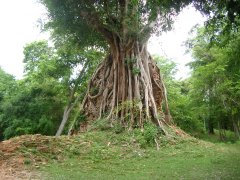 Almost by chance, that is, if we hadn't been "adopted" by a group of the local children. In most places we've visited so far we've had children rushing up to us as soon as we've arrived trying to sell us "guidebooks - one dollar"; "postcards - one dollar"; "two flutes - one dollar". Usually, as soon as we headed towards the temple they dropped back and looked for more potential buyers. Not at Sambor Prei Kuk as we were almost the only visitors there! One boy, the eldest of the group but no more than about eleven, appointed himself as our guide. Neither Martin nor I wanted a guide but he didn't take the hint and he and all the rest of the kids (ages from about 5 years) trailed round the site with us. Two little girls took a particular interest in Martin and hovered closely one on either side of him all the way round the site. If they got separated from him they quickly scurried back into position quite content just to walk alongside with no attention from him at all. It must be nice to be adored by all the girls - must be the blond hair.
Almost by chance, that is, if we hadn't been "adopted" by a group of the local children. In most places we've visited so far we've had children rushing up to us as soon as we've arrived trying to sell us "guidebooks - one dollar"; "postcards - one dollar"; "two flutes - one dollar". Usually, as soon as we headed towards the temple they dropped back and looked for more potential buyers. Not at Sambor Prei Kuk as we were almost the only visitors there! One boy, the eldest of the group but no more than about eleven, appointed himself as our guide. Neither Martin nor I wanted a guide but he didn't take the hint and he and all the rest of the kids (ages from about 5 years) trailed round the site with us. Two little girls took a particular interest in Martin and hovered closely one on either side of him all the way round the site. If they got separated from him they quickly scurried back into position quite content just to walk alongside with no attention from him at all. It must be nice to be adored by all the girls - must be the blond hair.
Our guide proved to be quite useful in helping us to find our way through the trees and pointed out the bomb crater where a US bomb fell (not mentioned in the guidebook). This happened when the Americans were trying to open the road from Phnom Penh to Siem Reap during the civil war. Several of the temples had been destroyed as a result. Not a bad effort considering the road was 20-25 km away to the south.
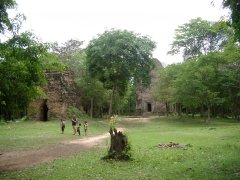 Having shaken off our tails (only achieved by getting into the car), we headed back to the main road and Kompong Thom. The most highly (Lonely Planet) recommended hotel was easy to find as it was large and right on the main road. It had been refurbished comparatively recently and actually boasted a lift. The furnishings were new and quite smart, the beds were clean and comfortable if a bit hard, the room was air conditioned, had a fridge and TV and was even cheaper than we'd paid at Siem Reap. What we didn't check before taking the room was the TV which refused to be switched on. We also couldn't have known that the air conditioning would stop working during the night and that some thoughtful soul in a speaker van would come round the streets outside the hotel at 7:00 am to harangue the local populace - and us.
Having shaken off our tails (only achieved by getting into the car), we headed back to the main road and Kompong Thom. The most highly (Lonely Planet) recommended hotel was easy to find as it was large and right on the main road. It had been refurbished comparatively recently and actually boasted a lift. The furnishings were new and quite smart, the beds were clean and comfortable if a bit hard, the room was air conditioned, had a fridge and TV and was even cheaper than we'd paid at Siem Reap. What we didn't check before taking the room was the TV which refused to be switched on. We also couldn't have known that the air conditioning would stop working during the night and that some thoughtful soul in a speaker van would come round the streets outside the hotel at 7:00 am to harangue the local populace - and us.
Having bought bread and fruit at the local market we continued on our way via Kompong Cham to Kratie on the east bank of the Mekong River about 350 km northeast of Phnom Penh. The journey was again for the most part on well maintained, paved roads. The dreadful unpaved section made up for the rest of the journey as the condition was worse than anything else we had experienced. The tarmac suddenly ended and as suddenly started again some 15-20 km later. In between, we found a few reasonable stretches which allowed speeds of up to about 30 mph but long stretches had enormous potholes and puddles that on occasion took us through water that came above the car's axles. At one point we actually moved off the road itself and picked our way through the trees of the rubber plantation that bordered the road.
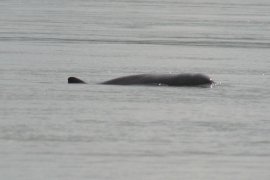 Kratie has little claim to fame except for the freshwater Irrawaddy dolphins which live in the Mekong River in ever decreasing numbers. We drove a few miles north of Kratie to a pool where one can reliably expect to see them. Locals take you out into the river for a reasonably modest charge in order to get close to them but they are shy animals and steer well clear of the boats so, while we had many sightings, they were never much closer than 50 yards away and most of the time much further. Martin had fitted his Acme "Super Intrusive" telephoto lens and managed to get a shot of one that shows half of its body and a back fin but it's still a very small image. But it's proof that we've notched up an endangered species on our "have seen" list.
Kratie has little claim to fame except for the freshwater Irrawaddy dolphins which live in the Mekong River in ever decreasing numbers. We drove a few miles north of Kratie to a pool where one can reliably expect to see them. Locals take you out into the river for a reasonably modest charge in order to get close to them but they are shy animals and steer well clear of the boats so, while we had many sightings, they were never much closer than 50 yards away and most of the time much further. Martin had fitted his Acme "Super Intrusive" telephoto lens and managed to get a shot of one that shows half of its body and a back fin but it's still a very small image. But it's proof that we've notched up an endangered species on our "have seen" list.
On our way back to Kratie we called in at a small phnom (hill) with an unimpressive little temple on the top. Justification for the short diversion was the prospect of "good views over the Mekong". That must have been written quite some time ago as trees now obstruct the view. Having climbed up what seemed like hundreds of steps to get to the top and stumbled back down, at least we felt that we'd had a bit of exercise that day so it wasn't a complete waste of time.
Then it was back to Kratie to check into another $12 hotel and find some food. Again the hotel was basic (as you'd expect for the price) but clean and comfortable and having slept well we got ready to move on to Phnom Penh. It was a long drive - about 350 km - but, for the most part, the roads were good and the only delaying factor was the number of kamikaze motorbike drivers who kept trying to drive under the wheels of the car. Martin took it all in his stride - he's obviously hardened to it - but like my other son, Richard, who spent time with Martin in India, I had to keep redefining my definition of "Phew! That was close".
We headed for the town centre and the riverfront road which is where most of the Lonely Planet recommended hotels were situated. For the most part they seemed to be unsuitable as we felt we needed off-road parking for the Landcruiser - not easy to find in the centre of the city. On making a second pass we saw one with parking in front of the hotel on what should have been the pavement. We decided to check it out and negotiated a price that was high by Martin's currently enforced frugal standards but not by mine (on this leg of the journey it's "The Father will pay") so we checked in. There was just time, before it got dark, for an orientation walk to get a feel for the city. The walk took us to Wat Phnom which is a small temple set on top of a 27m-high tree-covered hill.
Legend has it that the city of Phnom Penh was founded when an old woman called Penh found four Buddha images that had come to rest on the banks of the Mekong River. She housed them on a nearby hill and the town that grew up here came to be known as Phnom Penh (Hill of Penh). On the hill today is a simple temple and a stupa (mausoleum) containing the ashes of King Ponhea Yat who reigned from 1405 to 1467. In a small pavilion between the temple and the stupa is a statue said to be of Madame Penh. What became of the original four Buddhas is not recorded.
On our way back to the hotel and evening meal, we passed through the centre of one of the food markets - at times not a pleasant sight, especially the meat and fish sections where the flies were numerous and the foodstuffs were not covered. Not comforting either when one considers that the food served in most of the surrounding restaurants must have come from this market. On which subject, as there has been little to report for this day, mostly spent travelling, this is an opportune moment to satisfy the gourmets/gluttons amongst our readership and discourse on the food we've experienced in Cambodia.
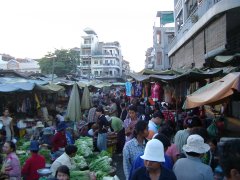 Our breakfasts have ranged from fresh fruit bought at local markets to cooked "western" food in hotels. The fruit has included mangoes, papaya, water melon, bananas and some strange, small fruits about 2-3 cm in diameter, which when unpeeled yielded 2 or 3 segments of white flesh with a black pip at the centre. I tried one and thought I liked it so bought some - Martin turned his nose up. I later realised that neither the flavour nor the amount of flesh to be had from each fruit justified the amount of effort one had to expend to get at it. More than half ended up in the bin. In Siem Riep we found a small restaurant around the corner from our hotel where they served "western" breakfasts but the photos in the menu (they all have photos of what you're going to get, in the menu) looked most unappetising. We settled on a platter of mixed fresh fruit topped with very good yoghurt. This became a regular visit for each of the four days we were there. Lunch, apart from the flapjack mentioned in my previous report has consisted of fruit (again), bread, cheese (courtesy of New Zealand) and slices of some sort of meat sausage with chillies (from Thailand).
Our breakfasts have ranged from fresh fruit bought at local markets to cooked "western" food in hotels. The fruit has included mangoes, papaya, water melon, bananas and some strange, small fruits about 2-3 cm in diameter, which when unpeeled yielded 2 or 3 segments of white flesh with a black pip at the centre. I tried one and thought I liked it so bought some - Martin turned his nose up. I later realised that neither the flavour nor the amount of flesh to be had from each fruit justified the amount of effort one had to expend to get at it. More than half ended up in the bin. In Siem Riep we found a small restaurant around the corner from our hotel where they served "western" breakfasts but the photos in the menu (they all have photos of what you're going to get, in the menu) looked most unappetising. We settled on a platter of mixed fresh fruit topped with very good yoghurt. This became a regular visit for each of the four days we were there. Lunch, apart from the flapjack mentioned in my previous report has consisted of fruit (again), bread, cheese (courtesy of New Zealand) and slices of some sort of meat sausage with chillies (from Thailand).
Cambodian food is usually described as being similar to Thai food and that's what we've set out to sample each evening. Not being a connoisseur of Thai food I couldn't hope to put my finger on what the differences are, but similar they certainly seem to be. The range and combinations of spices are largely the same.
Fried spring rolls are available in many places, similar to those served in Chinese restaurants in the UK but with a slightly different, delicately spiced flavour. Also available are fresh spring rolls which we tried on one occasion. They consisted mostly of lettuce with a few other salad vegetables wrapped in a soft, almost translucent wrapper. Not unpleasant but not, in our opinion, worth repeating the experience.
Soups, especially noodle soup, are a big Cambodian thing and there are many to choose from but they have not appealed to us. Amok is probably the most distinctive dish we've yet come across. It consists of baked fish with coconut, lemon grass and chilli served in a bowl cleverly made from a banana leaf. We found that it's also available with chicken or pork but we've stuck with the more traditional fish. On each occasion it's been delicious and in each restaurant it's been subtly different. Definitely still on the agenda but we're taking a break for a while to sample other things. Another national speciality is Lok Lak which consists of finely sliced beef served in a lightly spiced sauce on a bed of sliced tomato - in one case green tomato. On one occasion the beef was a little chewy but the dish served here in Phnom Penh was delicious.
Other dishes include the usual chicken, pork, beef, shrimps, etc., stir-fried with various combinations of vegetables, herbs and spices. Frequently a generously applied ingredient is lemon grass; also chilli figures in many of the dishes.
Not all the food has been to our liking though and our experience in one overnight stop left us full but not entirely satisfied. The food was similar in main ingredients to what we'd had previously but had little, if any, flavouring (spices or sauces) added which meant that they tasted insipid and uninteresting. The chicken was obviously one of the scrawny little things that Martin has been trying to run over for the last 1000 km and had been chopped up into small pieces without being boned. Consequently we kept crunching on shards of bone and spitting them out. This was a huge restaurant in a small town and obviously popular with the locals so may have been a true representation of what everyday Cambodian food is like. If so, we'd better keep on the tourist food trail.
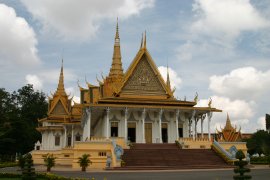 On our first full day in Phnom Penh, we decided we should start with a little culture so set off for the Royal Palace and Silver Pagoda. This was within easy walking distance of our hotel. The whole complex consists of up to 20 small and large structures the most significant of which were the Pagoda itself and the Throne Hall.
On our first full day in Phnom Penh, we decided we should start with a little culture so set off for the Royal Palace and Silver Pagoda. This was within easy walking distance of our hotel. The whole complex consists of up to 20 small and large structures the most significant of which were the Pagoda itself and the Throne Hall.
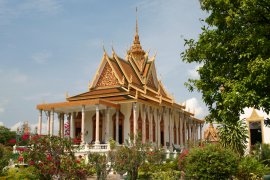 The Throne Hall is a cement-built building dating from 1919 which replaced an earlier wooden one on the same site. It is nicely decorated and painted largely in a sort of toffee/gold colour with green and blue embellishments. On top of the building is a spire-like tower which supposedly was inspired by the Bayon at Angkor. Apart from four faces pointing to the cardinal points, I wouldn't have made the connection myself if the guidebook hadn't told me. The Royal palace complex, which consists of an additional 10 structures surrounding the Throne Room, is enclosed by a 3-4 metre wall with a sort of cloistered gallery all round the inside. On the wall in the gallery is a continuous mural depicting the Ramayana, a traditional mythological epic. It was interesting to see scenes very reminiscent of the carvings we had already seen on the walls at Bayon at Angkor Thom. Unfortunately much of the lower part of the mural is damaged, probably from dampness rising up the wall. There didn't seem to be any evidence that it had been deliberately damaged by the Khmer Rouge when in occupation.
The Throne Hall is a cement-built building dating from 1919 which replaced an earlier wooden one on the same site. It is nicely decorated and painted largely in a sort of toffee/gold colour with green and blue embellishments. On top of the building is a spire-like tower which supposedly was inspired by the Bayon at Angkor. Apart from four faces pointing to the cardinal points, I wouldn't have made the connection myself if the guidebook hadn't told me. The Royal palace complex, which consists of an additional 10 structures surrounding the Throne Room, is enclosed by a 3-4 metre wall with a sort of cloistered gallery all round the inside. On the wall in the gallery is a continuous mural depicting the Ramayana, a traditional mythological epic. It was interesting to see scenes very reminiscent of the carvings we had already seen on the walls at Bayon at Angkor Thom. Unfortunately much of the lower part of the mural is damaged, probably from dampness rising up the wall. There didn't seem to be any evidence that it had been deliberately damaged by the Khmer Rouge when in occupation.
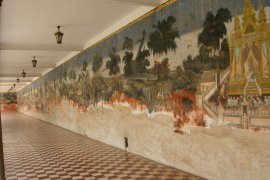 Tucked away in the enclosure surrounding the Royal Palace is a somewhat out-of-place structure. It is built on a conspicuously smaller scale than all of the rest of the buildings and in a completely different style. It is an iron built house presented by Napoleon III of France to King Norodom. It looks shabby and uncared for compared with the other magnificent buildings despite having been refurbished quite recently.
Tucked away in the enclosure surrounding the Royal Palace is a somewhat out-of-place structure. It is built on a conspicuously smaller scale than all of the rest of the buildings and in a completely different style. It is an iron built house presented by Napoleon III of France to King Norodom. It looks shabby and uncared for compared with the other magnificent buildings despite having been refurbished quite recently.
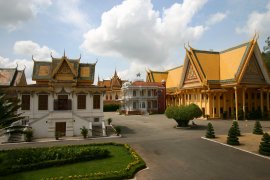 The Silver Pagoda, also surrounded by other structures (small temples, stupas, stutues, etc., is named after the floor made of 5000 silver tiles each weighing 1kg, but its real name is Wat Preh Keo (Pagoda of the Emerald Buddha). The silver floor is largely covered by carpet to protect it from the continuous passage of feet of visitors and worshippers. Some 40% of the Pagoda's contents remain having been preserved by the Khmer Rouge to demonstrate their concern to the outside world for the cultural heritage of Cambodia. Nonetheless, 60% disappeared and most other sites of cultural interest were desecrated or looted by them.
The Silver Pagoda, also surrounded by other structures (small temples, stupas, stutues, etc., is named after the floor made of 5000 silver tiles each weighing 1kg, but its real name is Wat Preh Keo (Pagoda of the Emerald Buddha). The silver floor is largely covered by carpet to protect it from the continuous passage of feet of visitors and worshippers. Some 40% of the Pagoda's contents remain having been preserved by the Khmer Rouge to demonstrate their concern to the outside world for the cultural heritage of Cambodia. Nonetheless, 60% disappeared and most other sites of cultural interest were desecrated or looted by them.
What remains is very impressive and littered with Buddhas of various sizes. Dominating the scene is the Emerald Buddha set on a dais. This is said to be made of Baccarat crystal although my Philistine son said that there was no reason to think that it was not made of plastic. In front of the dais stands a life-size gold Buddha studded with 9584 diamonds. The statue weighs 90 kg so it's quite a surprise that this was not looted too.
After a salad and sandwich lunch Martin decided he need a bit of retail therapy so we drove to the southern end of the city to explore the stalls of Psar Tuol Tom Pong (more commonly referred to by visitors as the Russian Market, as this is where the Russians shopped during the 1980s). Various areas of the market cater for most of one's needs although I couldn't see how I was going to fit a rotovator or even a chainsaw into my luggage. The big attraction, apart from real and fake antiques, wood carvings, silk fabric and clothing, musical instruments, etc., was the western brand name clothing from the likes of Gap, Columbia, Calvin Klein, Fruit of the Loom and even George at Asda. This clothing comes from the "accidental" production overruns at the local garment factories. So it's genuine gear at the price you'd expect to pay for fake stuff.
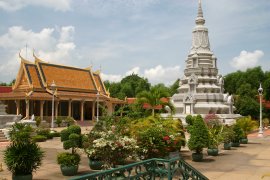 The market is covered by a low roof not much higher than the stalls themselves; the alleys between the stalls are only just wide enough for two people to pass each other. The heat and humidity is dreadful and there's absolutely no movement of air unless you're lucky enough to stand under a fan. It's difficult to understand how the stallholders endure it all day surrounded by their mountains of stock. Some of them sit perched up on top of and in the midst of their stock looking out through a small gap only just big enough to serve people through. After wandering up and down the aisles and fingering and trying on numerous items we each only came away with a shirt each. There was always something wrong - too long, too short, nothing big enough, wrong colour, wrong style.
The market is covered by a low roof not much higher than the stalls themselves; the alleys between the stalls are only just wide enough for two people to pass each other. The heat and humidity is dreadful and there's absolutely no movement of air unless you're lucky enough to stand under a fan. It's difficult to understand how the stallholders endure it all day surrounded by their mountains of stock. Some of them sit perched up on top of and in the midst of their stock looking out through a small gap only just big enough to serve people through. After wandering up and down the aisles and fingering and trying on numerous items we each only came away with a shirt each. There was always something wrong - too long, too short, nothing big enough, wrong colour, wrong style.
Next stop a fuel station for the car to be topped up with diesel. For those fans who have been concerned about Martin's intake of ice cream over the last few months (I'm not sure I remember a mention of it since Italy), I would like to put your minds at rest. In the filling station they were selling Walls products so we treated ourselves to a Magnum each.
And so it was back to the hotel to recharge our batteries in the air conditioned comfort of our room before venturing out for an evening meal of pasta and tiramisu in what might be the only Italian restaurant in the city that doesn't sell just pizza.
The next day we had allocated to the altogether more distasteful activity of visiting the Tuol Sleng Genocide Museum and the Killing Fields at Choeung Ek, about 5 km southwest of the city.
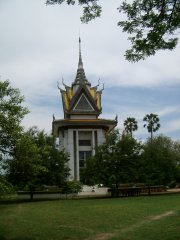 In 1975 the Tuol Svey Prey High School was taken over by Pol Pot and turned into Security Prison 21 (S-21). This soon became the largest centre of interrogation and torture in Cambodia. Estimates vary but from 1975 to 1978, between 12 and 17 thousand men, women and children passed through its doors. Only seven lived to tell the tale, all of whom had used their skills as artists or photographers to tell the tale. All of the rest had eventually been taken to the extermination camp at Choeung Ek.
In 1975 the Tuol Svey Prey High School was taken over by Pol Pot and turned into Security Prison 21 (S-21). This soon became the largest centre of interrogation and torture in Cambodia. Estimates vary but from 1975 to 1978, between 12 and 17 thousand men, women and children passed through its doors. Only seven lived to tell the tale, all of whom had used their skills as artists or photographers to tell the tale. All of the rest had eventually been taken to the extermination camp at Choeung Ek.
Following the fall of the Khmer Rouge regime in 1978, essential renovation work was carried out necessary to make it safe for public access and in 1980 it was opened as the Tuol Sleng museum. The place has been left largely as it was found and still houses the extensive written and photographic records kept by the captors. The torture rooms have been left empty of all but the simple iron beds on which the prisoners were beaten and crude but effective torture equipment. Elsewhere, one can see the poorly built brick or wooden partitions used to construct the 0.8m x 2m single cells and the 1m or 6m iron bars used to shackle as many as 30 prisoners in the large mass cells. Everywhere there are rows of hundreds of "mug shots" taken of each prisoner on admission to the prison. It is difficult to look at other more graphic photos.
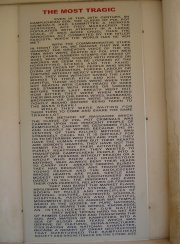 Martin and I had very little to say to each other as we walked around. The emotional effect was profound and I found myself, by stages, feeling anger, horror and disbelief at what those animals had done to their fellow human beings on little or no pretext. The most shocking thing to me was that, while the whole process was dreamed up by the diseased minds of Pol Pot and his henchmen, the majority of the captors, some as young as 10 years old, started out as apparently normal before growing increasingly evil. I was left wondering if, not far beneath the surface of all of us, there is a streak of inherent cruelty.
Martin and I had very little to say to each other as we walked around. The emotional effect was profound and I found myself, by stages, feeling anger, horror and disbelief at what those animals had done to their fellow human beings on little or no pretext. The most shocking thing to me was that, while the whole process was dreamed up by the diseased minds of Pol Pot and his henchmen, the majority of the captors, some as young as 10 years old, started out as apparently normal before growing increasingly evil. I was left wondering if, not far beneath the surface of all of us, there is a streak of inherent cruelty.
I left the place feeling quite depressed as we moved on to the extermination camp of Choeung Ek (The Killing Fields). Having seen photographs of the site taken during the exhumation of the mass graves in 1980 I was prepared for the worst. However, today it is a quiet and peaceful place. There are continual reminders of what went on there in the form of small piles of human bones left by the path and a memorial stupa containing more than 8000 skulls arranged behind glass panels. More powerful to me though were the fragments of victims' clothing that protrude from the earth everywhere along the paths which wander around the exhumation pits.
There is much more that could be written about our visit to these places but not in a family-oriented website like this. For those wishing to learn more, the following link provides additional detail.
http://en.wikipedia.org/wiki/Tuol_Sleng
To counter the effects of our morning we returned to the hotel, parked the car and went in search of lunch. Contrary to our normal rule of a light snack of bread, cheese, fruit, etc., we selected a bar/restaurant which, in honour of the mango season, was serving mango and chicken curry with rice. This proved to be excellent, flavoured more like an Indian curry than the Khmer food we'd tasted previously. Portions were very generous and left me feeling that the best afternoon activity would be prolonged and detailed examination of the inside of my eyelids.
However Martin had other ideas and I plodded off behind him as we made our way to the Central Market. This proved to be much superior to the Russian Market that we'd visited the previous day and to which all tourists are advised to go. The stalls were far more widely spaced and the whole place felt much more open and airy. It also helped that the stalls themselves were laid out so one could see the range of stock available - unlike the jumble sale stalls we'd fought our way past before. Martin was soon haggling like a veteran (his mother would be proud of him) and even walked away from one stall keeper who wouldn't bring her price down low enough - always a good ploy - but this time it didn't work so he had to eat humble pie and go back later for his $4.00 shirt.
On our way back to the hotel we came across a dusty Toyota Landcruiser with roof rack piled high that look somehow familiar parked by the side of the road. Sitting nearby, tackling their dehydration, were Alex and Maz with Frazer, Alex's brother who had joined them from a business trip in neighbouring Vietnam. After the reunion greetings, we joined them for our own liquid refills and a catching up chat for an hour or so. Having arranged where to meet for dinner, we left them to scout out the city for suitable accommodation.
We had opted for Friends, an NGO called Mith Samlanh which has made a real name for itself with an interesting menu of tapas and a list of special dishes. The restaurant is non profit-making and provides former street children with an opportunity to learn a trade in the hospitality industry. Many trainees at Friends have gone on to work in leading hotels and restaurants in the town. We chose two tapas dishes each plus some rice but all took a share of each dish as it came. They were all delicious and it proved to be a good way of sampling a wide range of Khmer cooking. We parted company with Maz, Alex and Frazer at around 10.00pm leaving them still with accommodation to sort out.
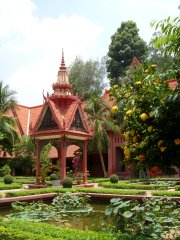 The only item left on the tourist trail list for our final day in Phnom Penh was the National Museum which we visited in the morning. It is a small museum but contains a good selection of artefacts from all periods and all regions of the country. It is built on four sides surrounding a delightful courtyard garden consisting of four square ponds in which lotus flowers grow. The afternoon became one of Internet activity for Martin and diary writing for me.
The only item left on the tourist trail list for our final day in Phnom Penh was the National Museum which we visited in the morning. It is a small museum but contains a good selection of artefacts from all periods and all regions of the country. It is built on four sides surrounding a delightful courtyard garden consisting of four square ponds in which lotus flowers grow. The afternoon became one of Internet activity for Martin and diary writing for me.
That evening we met up with Alex, Maz and Frazer and went for an excellent Khmer meal. The evening's entertainment was provided by one of the waiters who was clearly a female trapped in a male body. I was reminded of the sketches in the TV series "Little Britain" as I am sure that if he'd known the catch phrase, he'd have kept saying "I'm a lady". His face was grotesquely made up and, I suspect he'd had facial surgery to improve his looks but, if so, the surgeon shouldn't have used Michael Jackson as a model. The low point of the evening was when he insisted on comparing fingernails with Maz! And so, it was time for bed, ready to move on the Cambodian coast the next day.
| All content copyright � overland-underwater.com - please do not use without permission. |
